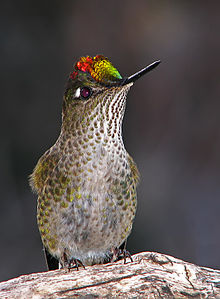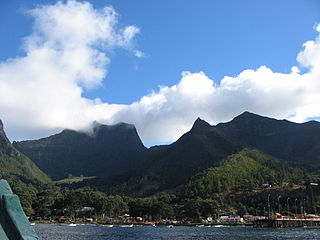
The Juan Fernández Islands are a sparsely inhabited series of islands in the South Pacific Ocean reliant on tourism and fishing. Situated 670 km off the coast of Chile, they are composed of three main volcanic islands: Robinson Crusoe, Alejandro Selkirk and Santa Clara. The group is part of Insular Chile.

Hummingbirds are birds native to the Americas and comprise the biological family Trochilidae. With about 366 species and 113 genera, they occur from Alaska to Tierra del Fuego, but most species are found in Central and South America. About 28 hummingbird species are listed as endangered or critically endangered, with numerous species declining in population.

Lapageria is a genus of flowering plants with only one known species, Lapageria rosea, commonly known as Chilean bellflower or copihue. Lapageria rosea is endemic to Chile and it is the national flower of this country. It grows in forests in the southern part of Chile, being part of the Valdivian temperate rainforests ecoregion flora.

The giant hummingbird is the only member of the genus Patagona and the largest member of the hummingbird family, weighing 18–24 g (0.63–0.85 oz) and having a wingspan of approximately 21.5 cm (8.5 in) and length of 23 cm (9.1 in). This is approximately the same length as a European starling or a northern cardinal, though the giant hummingbird is considerably lighter because it has a slender build and long bill, making the body a smaller proportion of the total length. This weight is almost twice that of the next heaviest hummingbird species and ten times that of the smallest, the bee hummingbird.
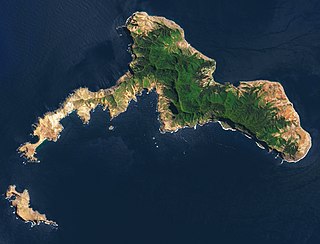
Robinson Crusoe Island is the second largest of the Juan Fernández Islands, situated 670 km west of San Antonio, Chile, in the South Pacific Ocean. It is the more populous of the inhabited islands in the archipelago, with most of that in the town of San Juan Bautista at Cumberland Bay on the island's north coast. The island was formerly known as Más a Tierra.

Alejandro Selkirk Island, previously known as Más Afuera and renamed after the marooned sailor Alexander Selkirk, is the largest and most westerly island in the Juan Fernández Archipelago of the Valparaíso Region of Chile. It is situated 180 km west of Robinson Crusoe Island in the southeastern Pacific Ocean.

The green-backed firecrown is a hummingbird in the "coquettes", tribe Lesbiini of subfamily Lesbiinae. It is found in Argentina, mainland Chile, and the Juan Fernández Islands.

The Juan Fernández firecrown is a Critically Endangered hummingbird in the "coquettes", tribe Lesbiini of subfamily Lesbiinae. It is endemic to Isla Róbinson Crusoe, one of the three-island Juan Fernández archipelago belonging to Chile.

The red-tailed comet is a medium-sized hummingbird belonging to the family Trochilidae. It is the only species placed in the genus Sappho.
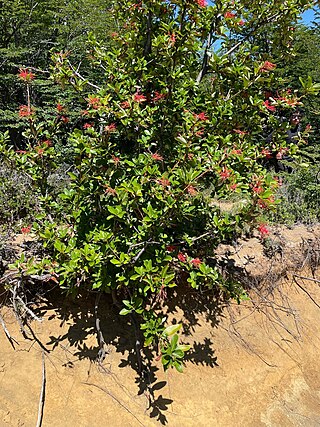
Embothrium is a genus of two to eight species in the plant family Proteaceae, native to southern South America, in Chile and adjacent western Argentina; the genus occurs as far south as Tierra del Fuego. Common names include Chilean firebush in English, notro in Argentina, ciruelillo, fosforito or notro chileno in Chilean Spanish.
The Hummingbird Society is a non-profit organization whose mission is to promote the understanding and conservation of hummingbirds. It was founded in 1996 by Dr. H. Ross Hawkins, who was its executive director until he died in early July 2020. His work and the Society continue and hummingbird lovers around the world acknowledge his enormous contribution. The Society's offices are currently at 6560 Highway 179, Suite 124, Sedona, Arizona, USA. Members can be found in all U.S. states and over twenty other countries.
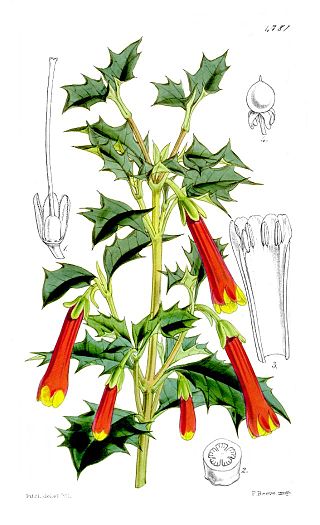
Desfontainia is a genus of flowering plants in the family Columelliaceae, though it was placed formerly in Loganiaceae, Potaliaceae, or a family of its own, Desfontainiaceae.

Archipiélago de Juan Fernández National Park is a national park located in the Pacific Ocean 665 kilometres west of Chile's mainland port of San Antonio, in the Juan Fernández Archipelago. The park covers 96 square kilometres and comprises the Santa Clara, Alejandro Selkirk and the most part of the Robinson Crusoe Island islands.

Vicente Pérez Rosales National Park is located in Los Lagos Region, Llanquihue Province, of Chile. Its western entrance is close to the Ensenada locality, 82 km (51 mi) northeast of the provincial capital of Puerto Montt, and 64 km (40 mi) from Puerto Varas along Ruta CH-225. This national park covers about 2,530 km2 (977 sq mi) and is almost entirely in the Andes mountain chain. The adjacent national parks Vicente Pérez Rosales and Puyehue National Park in Chile, and Nahuel Huapi National Park and Lanín National Park in Argentina, provide a continuous protected area of close to 15,000 km2 (5,792 sq mi).
Juan Fernández may refer to:

The Chilean woodstar is a Critically Endangered species of hummingbird in tribe Mellisugini of subfamily Trochilinae, the "bee hummingbirds". It is the only species placed in the genus Eulidia. It is endemic to Chile though there are unconfirmed reports from southern Peru. The species' name commemorates the English naturalist William Yarrell.

The oasis hummingbird is a species of hummingbird in tribe Mellisugini of subfamily Trochilinae, the "bee hummingbirds". It is the only species placed in the genus Rhodopis. It is found in Chile and Peru

The Peruvian sheartail is a species of hummingbird in tribe Mellisugini of subfamily Trochilinae, the "bee hummingbirds". It is the only species placed in the genus Thaumastura. It is found in Chile, Ecuador, and Peru.
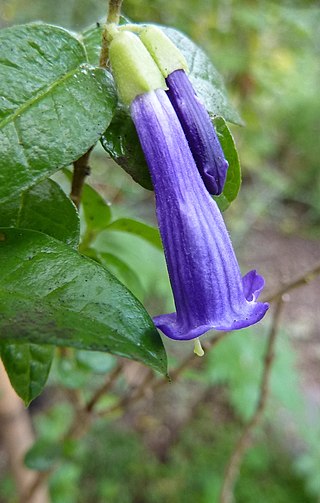
Rhaphithamnus venustus, known locally as Juan Bueno, is a species of plant in the family Verbenaceae. It is endemic to the Juan Fernández Islands, an archipelago west of Chile. It is threatened by habitat loss.
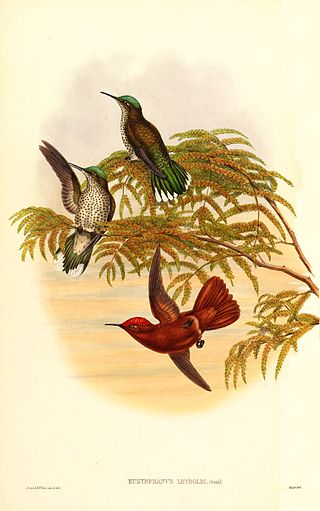
Friedrich Leybold was a German-Chilean pharmacist and naturalist.
